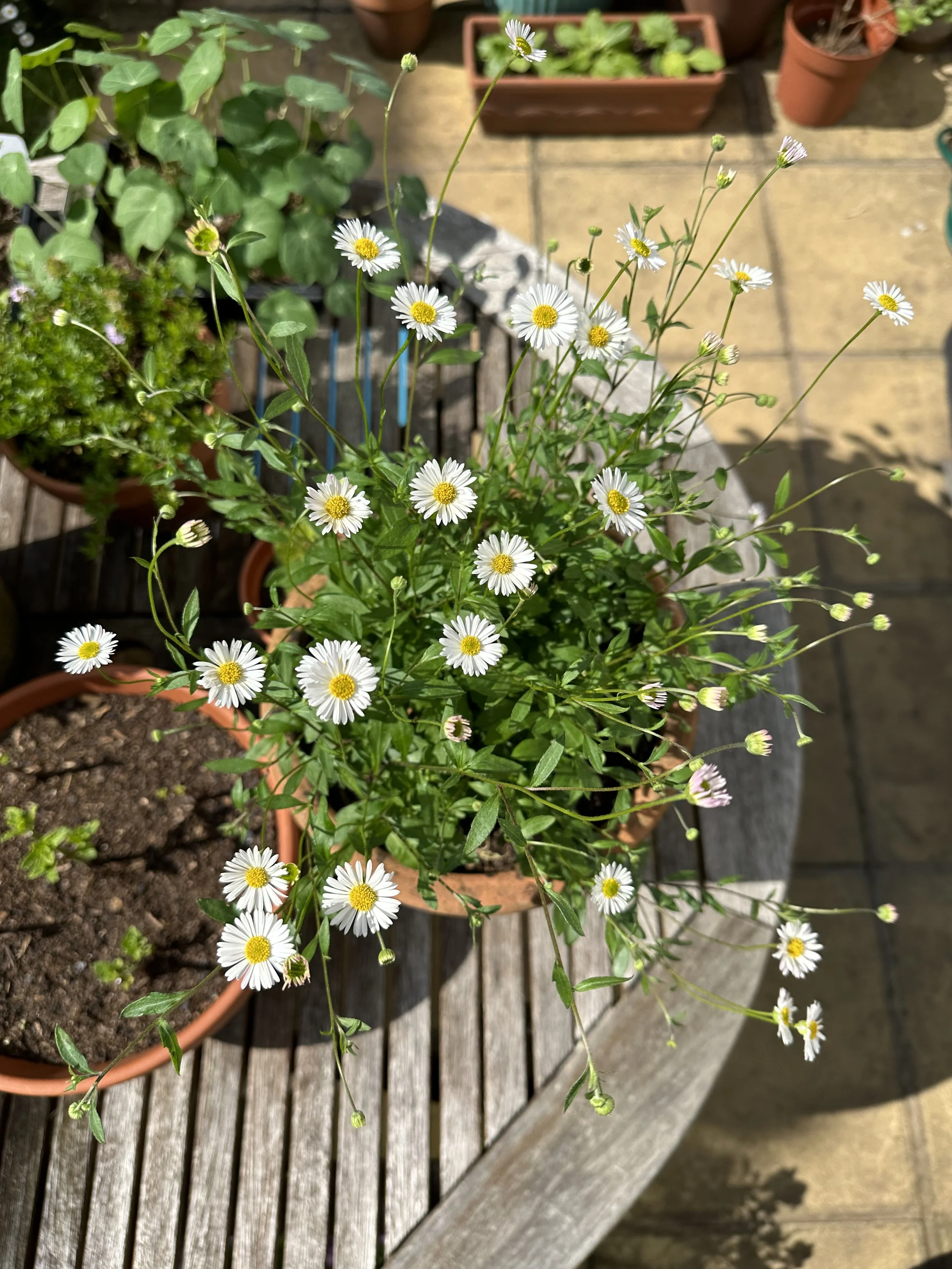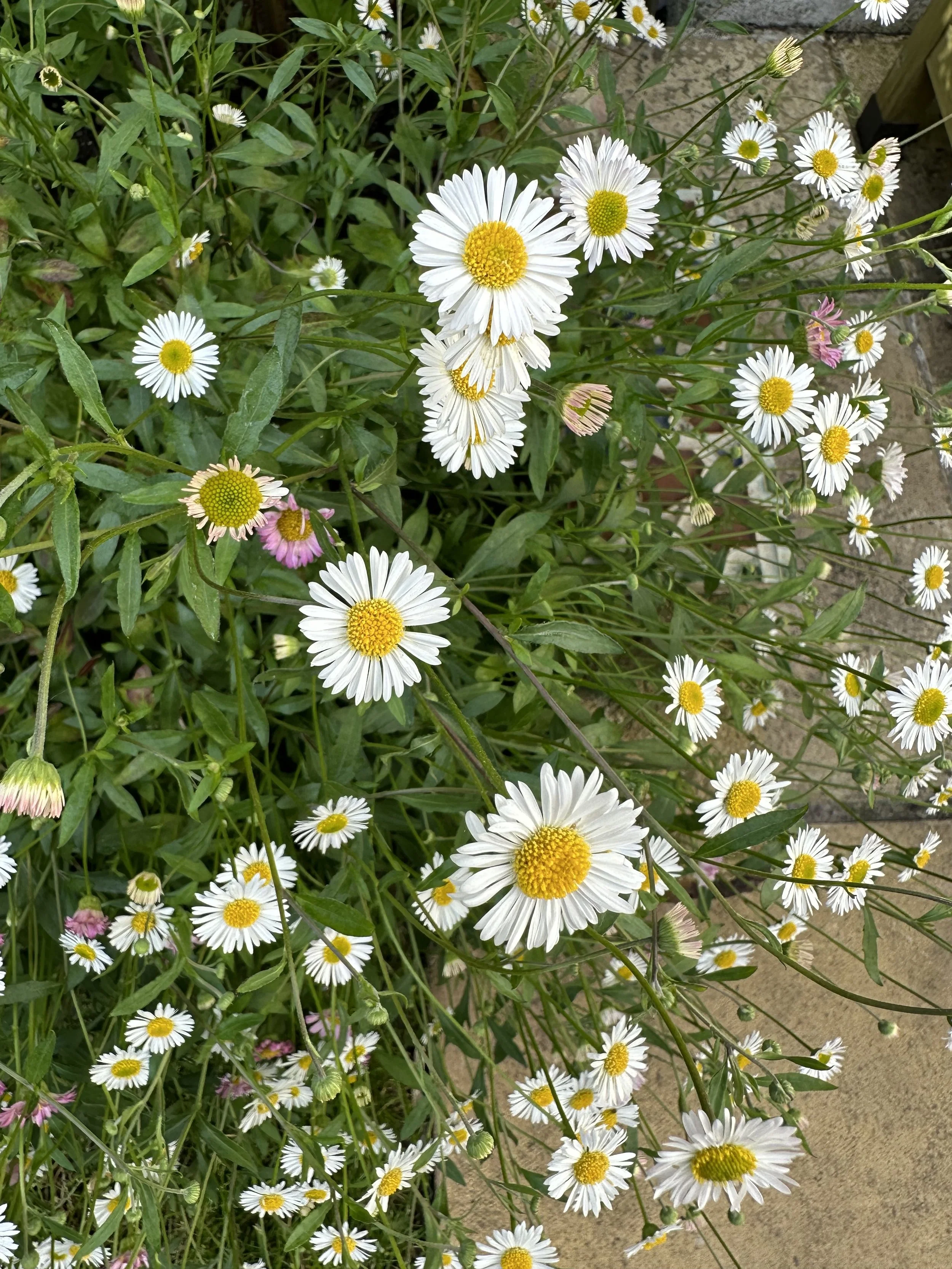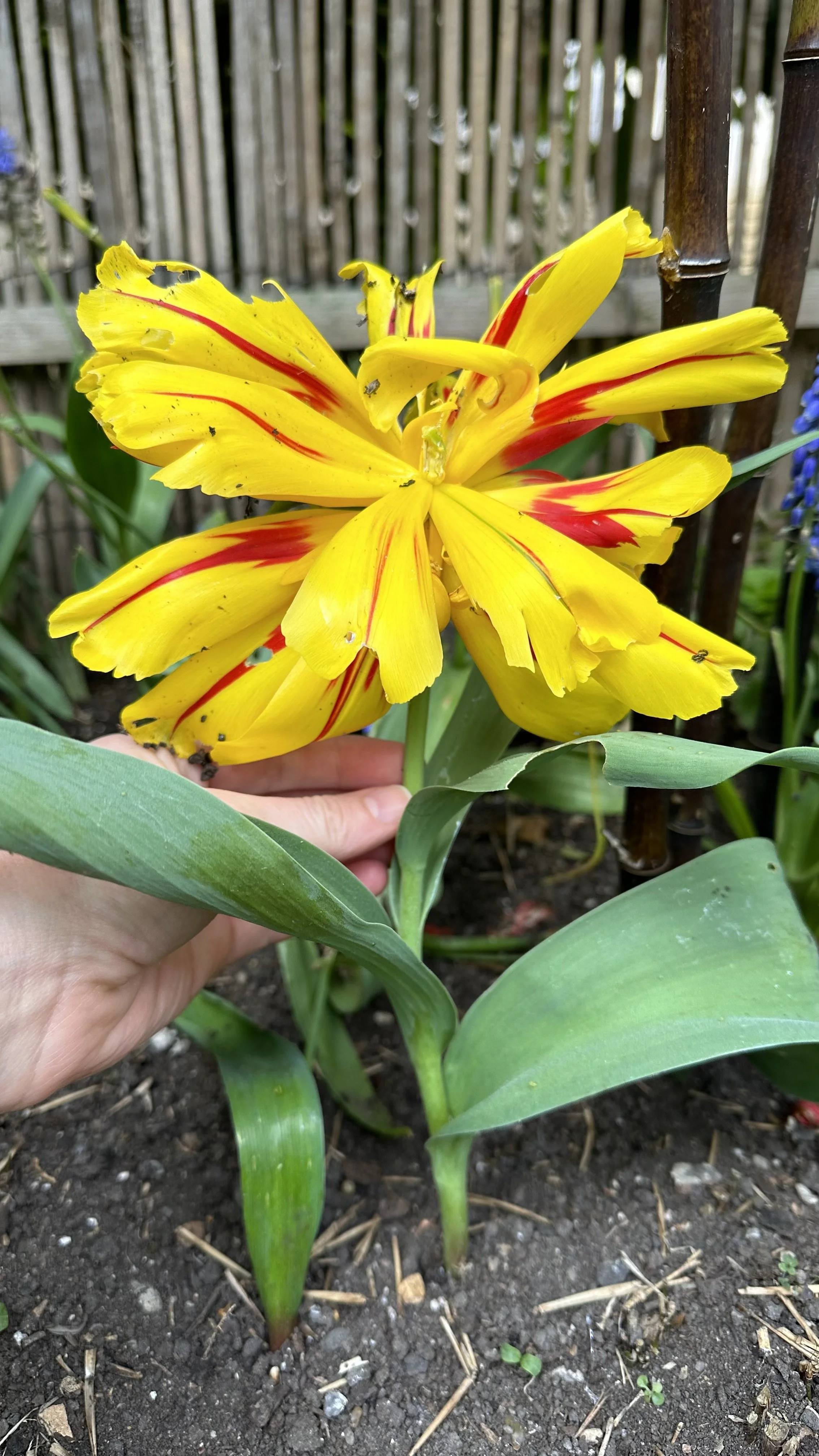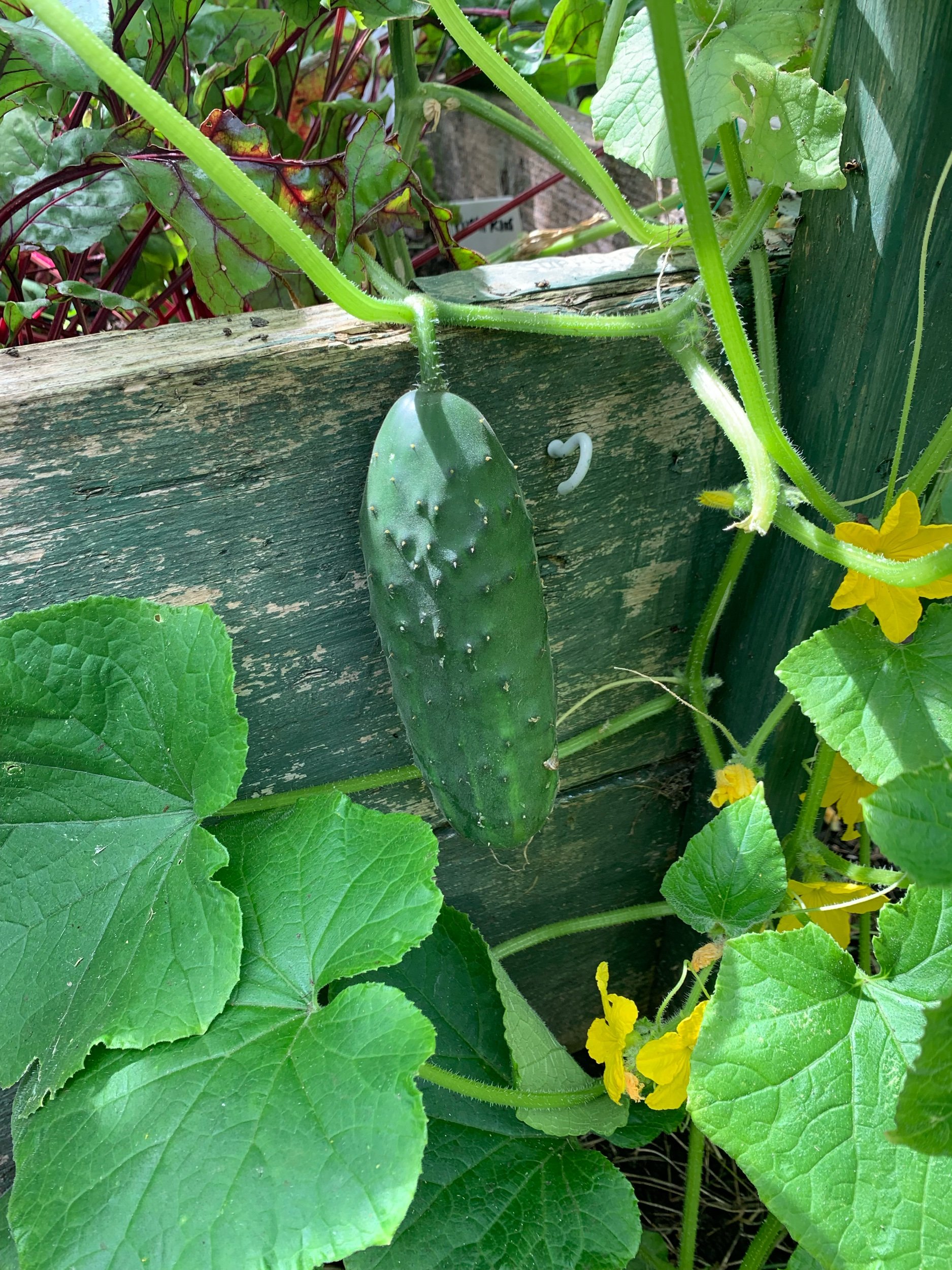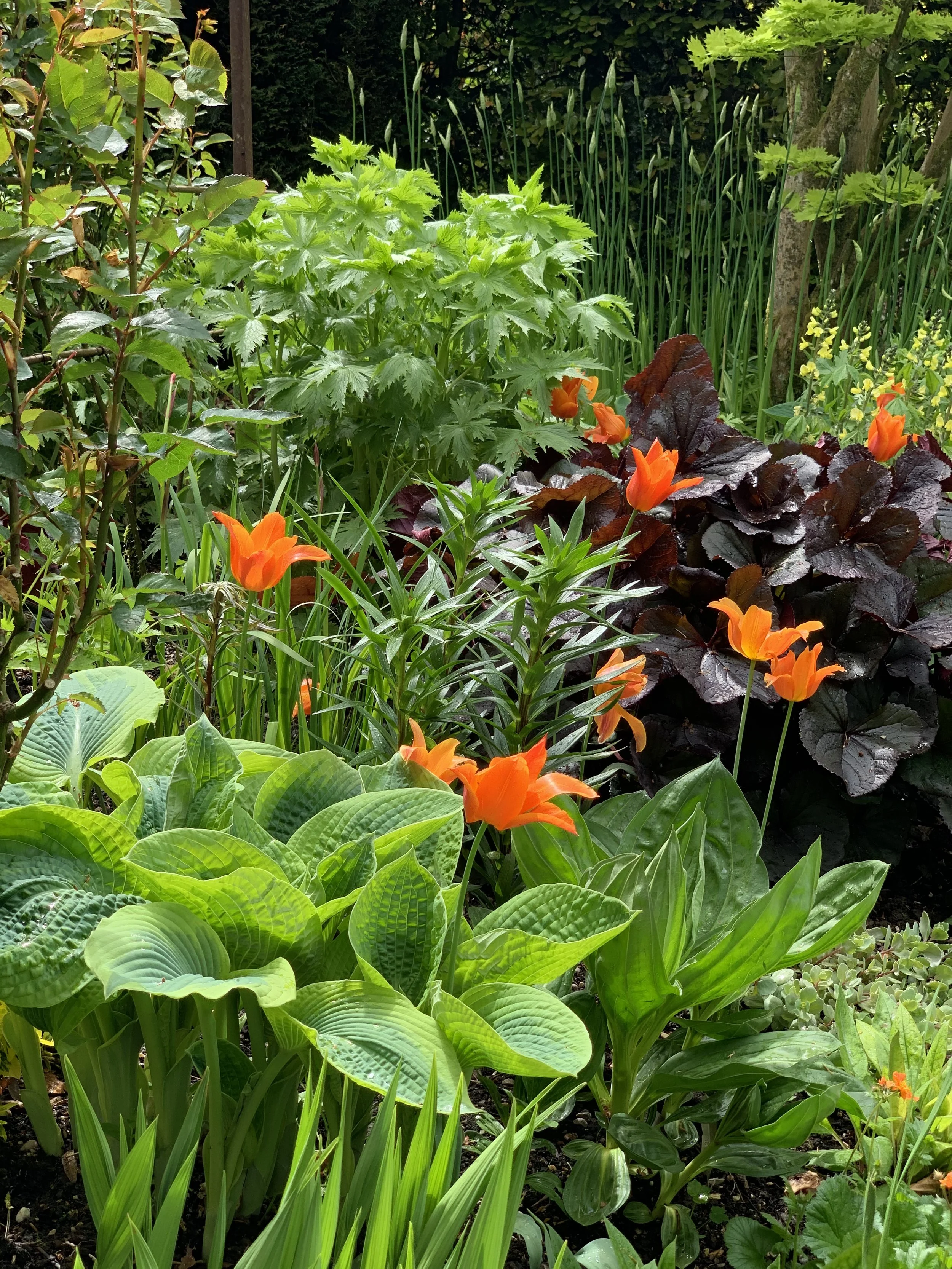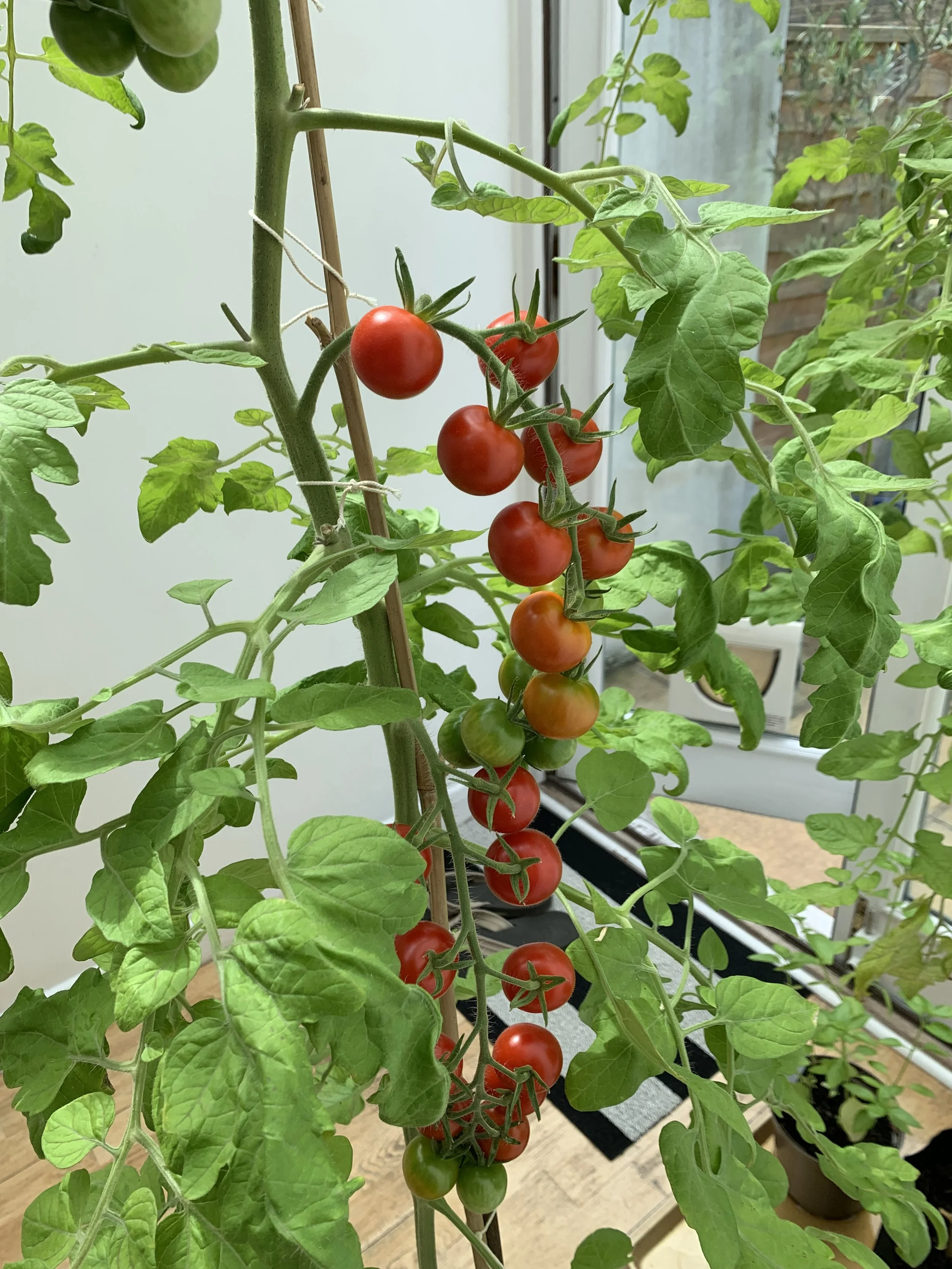Erigeron Karvinskianus: Growing Ground Cover for Pollinators
This article has links to products that I may make commission from.
Erigeron Karvinskianus, commonly known as Mexican Fleabane or Santa Barbara Daisy or Mexican Daisy, is a delightful ground cover plant that adds a touch of beauty to any garden.
With its dainty flowers and ability to attract beneficial insects, this Latin American native has become a favorite among gardeners worldwide. I first spotted Erigeron at Kiftsgate Garden in the Cotswolds and have been growing it ever since.
Here we will explore the characteristics of Erigeron Karvinskianus, discuss its growing requirements, and provide tips for successful cultivation.
To learn more about growing flowers for pollinators, check out my guides Utilizing Nasturtium Companion Plants for Natural Pest Control and Companion Planting Yarrow: Attracting Beneficial Insects.
Erigeron Karvinskianus, also referred to as Latin American or Mexican Fleabane, is a perennial herbaceous plant that belongs to the Asteraceae family. Native to Central America, particularly Mexico, it has gained popularity for its adaptability and charming appearance.
It is known for its profusion of delicate flowers that bloom from spring to fall, adding a vibrant display of pink and white hues to gardens and landscapes.
It has been awarded the prestigious Royal Horticultural Society (RHS) Garden Merit. The RHS Garden Merit is a recognition given to plants that have been extensively tested and proven to perform well in garden conditions.
Erigeron Karvinskianus received the RHS Garden Merit due to its desirable qualities, including its attractive flowers, ease of cultivation, and ability to thrive in a variety of garden settings. This is a designation that serves as a reliable indication of the plant's reliability in gardens.
Is erigeron karvinskianus perennial?
Yes, Erigeron Karvinskianus is a perennial plant.
Perennial plants are those that live for more than two years, with Erigeron Karvinskianus typically persisting for several years in favorable growing conditions. As a perennial, Erigeron Karvinskianus has the ability to go through dormancy during unfavorable seasons, such as winter, and then regrow and bloom again in the following growing season.
In regions with mild winters or suitable climates, it may even remain evergreen and continue to produce flowers throughout the year.
When provided with proper care, including adequate sunlight, well-draining soil, and regular watering, Erigeron Karvinskianus can establish itself in the garden and become a reliable and long-lasting presence.
It's a popular choice for rock gardens, ground covers, borders, and container planting due to its hardiness and charming flowers. However, it's important to note that the longevity of perennial plants can be influenced by various factors, including climate, growing conditions, and specific plant varieties.
While Erigeron Karvinskianus is generally considered a perennial, individual plants may have variations in their lifespan depending on local conditions and care.
Is erigeron karvinskianus evergreen?
Erigeron Karvinskianus, commonly known as Santa Barbara Daisy or Mexican Daisy, is typically considered a semi-evergreen perennial.
This means that it may retain its foliage throughout the year in mild climates or areas with relatively mild winters. In regions with mild winters, Erigeron Karvinskianus can often remain evergreen, meaning it retains its leaves and foliage year-round.
This can provide continuous greenery and occasional blooms even during the winter months.
However, in colder climates or during harsh winters, Erigeron Karvinskianus may lose some or all of its foliage and go dormant. The plant may die back to the ground and then regrow from the base in the following spring when temperatures become more favorable.
The extent of its evergreen behavior may vary depending on the specific climate, temperature fluctuations, and growing conditions in your area. In colder regions, it's common for Erigeron Karvinskianus to exhibit a deciduous or semi-deciduous habit.
Regardless of its evergreen status, Erigeron Karvinskianus is appreciated for its profuse flowering and cascading foliage, which adds charm and beauty to gardens, borders, and container plantings.
With proper care and suitable conditions, you can enjoy its delicate flowers and foliage year-round or during the active growing season in your specific climate.
My recommended pick for Erigeron Karvinskianus Seeds.
Is erigeron karvinskianus invasive?
Erigeron Karvinskianus, commonly known as Santa Barbara Daisy or Mexican Daisy, has the potential to become invasive in certain regions.
However, its invasiveness can vary depending on the specific location and environmental conditions. Erigeron Karvinskianus is native to Mexico and Central America but has been widely cultivated and naturalized in many parts of the world.
It is known for its ability to self-seed and spread readily in favorable growing conditions. The plant produces numerous small seeds that can be dispersed by wind, water, or through the movement of animals and garden debris.
In some regions with mild climates, Erigeron Karvinskianus can escape from cultivation and establish itself in natural areas, roadsides, and disturbed habitats. It can form dense populations and compete with native vegetation, potentially impacting local biodiversity and ecological balance.
Therefore, it is important to be cautious when growing Erigeron Karvinskianus, especially in areas where it is not native. To prevent potential invasiveness:
Be mindful of planting it in regions where it is not already naturalized or established.
Regularly deadhead the flowers to prevent the formation and dispersal of seeds.
Monitor its growth and spread, and take necessary actions to control its expansion if it starts to overwhelm native plant populations.
Consider planting Erigeron Karvinskianus in containers or confined garden beds to restrict its spread.
Can You Divide Erigeron Karvinskianus?
Erigeron Karvinskianus can be divided to propagate and expand the plant.
Here's a step-by-step guide on how to divide Erigeron Karvinskianus:
Timing
The best time to divide Erigeron Karvinskianus is in early spring or fall when the plant is not actively blooming.
This allows it to focus its energy on establishing new roots.
Preparation
Start by preparing the new planting location or pots for the divided plants.
Ensure that the soil is well-drained and of the appropriate pH level (neutral to slightly alkaline).
Watering
Water the plant thoroughly a day or two before dividing.
This helps to loosen the soil and reduce stress on the plant during the process.
For this, you can use rainwater harvested from a water butt.
Digging
Carefully dig up the entire Erigeron Karvinskianus plant using a garden fork or shovel.
Dig around the plant, keeping a generous distance from the outer edges to avoid damaging the roots.
Dividing
Once the plant is out of the ground, gently separate the root ball into multiple sections.
You can use your hands or a hori hori garden knife.
Each division should have its own set of roots and some healthy foliage.
Planting
Plant each divided section in the prepared soil or pots.
Dig a hole that is slightly wider and deeper than the root ball.
Place the division into the hole, making sure the crown is level with the soil surface.
Backfill the hole and firm the soil gently around the roots.
Watering and Care
After planting, water the divided Erigeron Karvinskianus thoroughly to help settle the soil and ensure good root-to-soil contact.
Keep the newly divided plants consistently moist but not waterlogged during the establishment period.
Provide them with the same care and growing conditions as the parent plant.
Monitoring
Monitor the divided plants closely for the first few weeks.
Keep an eye out for signs of stress, such as wilting or yellowing leaves.
Adjust watering and provide extra protection if needed, such as shading from intense sunlight or protection from frost.
By following these steps, you can successfully divide Erigeron Karvinskianus and expand your collection or share it with fellow gardeners.
Remember to be gentle with the roots and provide proper care to ensure the divisions establish themselves and thrive in their new locations.
Can you grow erigeron karvinskianus in pots?
Yes, Erigeron Karvinskianus can be grown in pots or containers, making it a versatile plant for both gardens and small spaces.
Here's a guide on how to grow Erigeron Karvinskianus in pots:
Selecting the Pot
Choose a pot or container that is large enough to accommodate the plant's root system and allows for proper drainage.
A container with drainage holes at the bottom is essential to prevent waterlogging.
Here are the pots I love using:
Potting Mix
Use a well-draining potting mix suitable for container gardening.
A mix containing equal parts of potting soil, perlite, or coconut coir works well for Erigeron Karvinskianus.
This will ensure adequate drainage while retaining some moisture.
Here is the organic potting mix I recommend using:
Planting
Place a layer of potting mix at the bottom of the container.
Gently remove the Erigeron Karvinskianus from its nursery pot or prepare a division if you're propagating.
Plant it in the center of the pot, ensuring the crown is level with the soil surface.
Backfill the remaining space with potting mix, firming it gently around the roots.
Watering
After planting, thoroughly water the container until water drains out of the bottom.
For this you can use rainwater collected from a water butt.
Allow the top inch of the soil to dry out slightly between watering sessions.
Avoid overwatering, as it can lead to root rot.
Adjust watering frequency based on the moisture needs of the plant and environmental conditions.
Sunlight
Erigeron Karvinskianus thrives in full sun but can tolerate partial shade.
Place the potted plant in a location that receives at least six hours of direct sunlight each day, like a south facing garden.
If growing indoors, choose a sunny spot near a window where the plant can receive adequate light.
Fertilizing
Feed Erigeron Karvinskianus with a balanced, water-soluble fertilizer once a month during the growing season (spring to fall).
Follow the instructions on the fertilizer package for the appropriate dilution rate.
Avoid over-fertilization, as it can lead to excessive foliage growth at the expense of flowers.
Here is the liquid fertilizer I recommend:
Maintenance
Regularly monitor the potted Erigeron Karvinskianus for any signs of pests or diseases.
Prune back any leggy or damaged stems to maintain a compact and tidy appearance.
Deadhead spent flowers to encourage continuous blooming.
Winter Care
In areas with mild winters, Erigeron Karvinskianus can remain in pots outdoors.
However, if you live in a region with harsh winters, consider moving the pot indoors to protect the plant from frost.
Place it in a cool but well-lit location, such as a bright window. Reduce watering during the dormant period.
How to Care for Erigeron Karvinskianus
Erigeron Karvinskianus is a relatively low-maintenance plant.
Here are some care tips to help you keep your Erigeron Karvinskianus healthy and thriving:
Watering
While Erigeron Karvinskianus is relatively drought-tolerant once established, regular watering is necessary during the initial stages of growth.
Water the plant deeply but infrequently, allowing the top inch of soil to dry out slightly between waterings.
Avoid overwatering, as it can lead to root rot. During hot and dry periods, you may need to increase watering frequency to keep the soil consistently moist.
Sunlight
Erigeron Karvinskianus thrives in full sun but can tolerate partial shade.
Ensure that the plant receives at least six hours of direct sunlight each day to promote healthy growth and abundant flowering.
In areas with intense heat, some afternoon shade may be beneficial.
Soil
Erigeron Karvinskianus prefers well-drained soil with a neutral to slightly alkaline pH level.
It can adapt to various soil types, including sandy or rocky soils. Ensure that the soil is loose and friable to allow for proper drainage and root development.
Fertilization
In general, Erigeron Karvinskianus doesn't require heavy fertilization.
However, you can apply a balanced, slow-release fertilizer in early spring to promote healthy growth and flowering.
Avoid over-fertilization, as it can result in excessive foliage growth rather than abundant flowers.
Here is the fertilizer I recommend using:
Pruning
Regular pruning helps maintain the plant's shape and encourages continuous blooming.
Deadhead spent flowers by removing them at the base of the stem to promote the production of new blooms.
Additionally, you can trim back any leggy or damaged stems to keep the plant compact and tidy.
Pruning can be done throughout the growing season as needed.
Winter Care
Erigeron Karvinskianus is typically hardy in mild climates and can remain evergreen.
However, in colder regions, it may die back during winter.
Apply a layer of mulch around the base of the plant to provide some protection and insulation.
Check out my guide: The Best Alternatives to Traditional Mulch for Your Garden.
If severe frost or freezing temperatures are expected, you can cover the plant with a frost cloth or move potted plants to a protected location.
Pest and Disease Control
Erigeron Karvinskianus is generally resistant to pests and diseases.
However, occasional problems such as aphids or powdery mildew may occur.
Monitor the plant regularly and take appropriate action if pests or diseases are detected.
You can use insecticidal soap or neem oil for controlling pests, and fungicides labeled for powdery mildew for disease management.
By following these care tips, you can ensure that your Erigeron Karvinskianus remains healthy, blooming profusely, and adds a delightful touch to your garden or landscape.
Equip your urban green space with my recommend top tier tools.
Should I cut back erigeron karvinskianus?
Yes, cutting back Erigeron Karvinskianus can be beneficial for the plant's overall health and appearance.
Here are some guidelines on when and how to prune Erigeron Karvinskianus:
Timing
Pruning is typically done in early spring before new growth begins or after the plant has finished flowering in the fall.
Avoid pruning during the peak blooming period to allow the plant to showcase its flowers.
Deadheading
Deadheading refers to the removal of spent flowers.
It is advisable to deadhead Erigeron Karvinskianus regularly to promote continuous blooming.
Snip off the faded flowers at the base of the stem, just above a set of healthy leaves or leaf node.
This encourages the plant to produce new flowers and prevents the formation of seeds.
Shaping and Maintenance
Erigeron Karvinskianus can become leggy or sprawl over time.
To maintain a more compact and tidy appearance, you can trim back the plant after flowering or in early spring.
Prune back any excessively long or straggly stems to promote a more bushy and attractive form.
Shearing
In some cases, if the plant becomes overly woody or untidy, a more drastic shearing can be done.
Shearing involves cutting back the entire plant to a few inches above the ground.
This rejuvenates the plant and encourages fresh growth.
However, keep in mind that shearing may sacrifice some blooms for a short period while the plant regrows.
Winter Care
In regions with mild winters, Erigeron Karvinskianus may remain evergreen and continue to produce some flowers.
In colder climates, the plant may die back during winter.
If that happens, wait until spring to assess the extent of winter damage before pruning.
Remove any dead or damaged stems, allowing new growth to emerge.
When pruning Erigeron Karvinskianus, it's essential to use clean and sharp pruning tools to make clean cuts and minimize the risk of introducing diseases.
Additionally, after pruning, consider applying a light layer of mulch around the base of the plant to help retain moisture and suppress weed growth.
By following these pruning guidelines, you can maintain the health, shape, and attractiveness of your Erigeron Karvinskianus plants, ensuring a vibrant display of flowers and foliage throughout the growing season.
Is erigeron karvinskianus frost hardy?
Erigeron Karvinskianus is generally considered to be frost hardy.
It can tolerate mild frosts and cool temperatures without significant damage.
However, it's important to note that its level of frost tolerance may vary depending on the specific climate conditions and the duration and intensity of the frost.
In regions with mild winters, Erigeron Karvinskianus may remain evergreen and continue to flower throughout the year. It can withstand light frosts and temperatures that dip slightly below freezing for short periods.
However, in areas with harsh winters and prolonged freezing temperatures, the plant may die back to the ground and go dormant until spring.
To protect Erigeron Karvinskianus during cold periods, you can take the following measures:
Mulching
Apply a layer of organic mulch, such as straw or wood chips, around the base of the plant.
This helps insulate the roots and protect them from extreme cold temperatures.
Here is the mulch I recommend:
Container Placement
If you are growing Erigeron Karvinskianus in containers, consider moving the pots to a sheltered location, such as a garage or protected area, during the coldest months. This provides additional protection against freezing temperatures.
Frost Cloth or Covers
In areas prone to frost, you can cover the plants with frost cloth or breathable covers overnight when frost is expected.
This helps trap some heat and provides a protective barrier against freezing temperatures.
It's worth mentioning that even if Erigeron Karvinskianus experiences frost damage or dies back during winter, it often regrows from the base in the following spring. Pruning back any damaged or dead foliage in early spring can help promote new growth and rejuvenation. If you live in an area with severe and prolonged freezing temperatures, you may need to consider treating Erigeron Karvinskianus as an annual or bring potted plants indoors during the winter months. Overall, while Erigeron Karvinskianus is relatively frost hardy, its specific tolerance to frost depends on various factors. It's always a good idea to monitor weather conditions in your region and provide appropriate protection when needed to ensure the plant's survival and vigor.
What to plant with erigeron karvinskianus
Erigeron Karvinskianus can be paired with various companion plants to create a beautiful and harmonious garden.
When selecting plants to accompany Erigeron Karvinskianus, consider factors such as complementary colors, growth habits, and preferred growing conditions.
Here are some plant suggestions that can work well alongside Erigeron Karvinskianus:
Lavender (Lavandula)
Both Erigeron Karvinskianus and lavender thrive in full sun and well-draining soil.
Their delicate flowers and aromatic foliage create a charming combination.
To learn more about growing lavender, check out my guides How to Create a Lavender Hedge and When Does Lavender Bloom?
Rosemary (Rosmarinus officinalis)
Rosemary is a fragrant herb that complements the dainty flowers of Erigeron Karvinskianus.
Both rosemary and Erigeron prefer full sun and well-drained soil.
Catmint (Nepeta)
Catmint produces clusters of lavender-blue flowers that contrast beautifully with the white or pink blooms of Erigeron Karvinskianus.
Both plants are drought-tolerant and attract pollinators.
Sedum (Stonecrop)
Low-growing sedums, such as Sedum 'Angelina' or Sedum spurium, make excellent ground cover companions for Erigeron Karvinskianus.
They create a carpet of colorful foliage and require similar growing conditions.
Achillea (Yarrow)
Yarrow offers vibrant flower clusters in various colors, including yellow, pink, and red.
Planting it alongside Erigeron Karvinskianus adds diversity and visual interest to the garden.
Echinacea (Coneflower)
The tall, cone-shaped blooms of Echinacea provide vertical interest and attract pollinators.
They can create a striking backdrop for the low-growing Erigeron Karvinskianus.
Check out my guide: The Perfect Partners: Echinacea Companion Planting Guide.
Together these flowers look beautiful in a wildflower garden.
Ornamental Grasses
Consider adding ornamental grasses like Pennisetum or Festuca to the garden.
The wispy foliage and graceful movement of grasses complement the delicate flowers of Erigeron Karvinskianus.
Verbena (Verbena bonariensis)
Tall, slender stems of Verbena bonariensis covered in purple flowers can add height and a vertical element to the garden, contrasting with the low-growing Erigeron Karvinskianus.
Remember to consider the specific growing requirements of each plant, such as sun exposure, soil type, and water needs, to ensure they are compatible and can thrive together.
Creating a diverse and balanced planting scheme with complementary colors, textures, and heights will enhance the overall beauty of your garden while providing a favorable habitat for beneficial insects and pollinators.
When to plant erigeron karvinskianus
Erigeron Karvinskianus is best planted during the spring or early summer when the soil has warmed up and the risk of frost has passed. The exact timing can vary depending on your specific climate and local conditions.
Here are some general guidelines for when to plant Erigeron Karvinskianus:
Spring Planting
In regions with mild or temperate climates, planting Erigeron Karvinskianus in early spring, after the last frost date, is ideal.
This allows the plant to establish its root system and acclimate to the growing conditions before the heat of summer.
Early Summer Planting
If you missed the spring planting window, you can also plant Erigeron Karvinskianus in early summer when the weather is warm and consistent.
Ensure that the plants receive adequate water during the establishment period.
It's important to note that Erigeron Karvinskianus is a perennial plant that can be grown from both seeds and nursery-grown plants.
If you are starting from seeds, it's recommended to start them indoors 6-8 weeks before the last frost date and transplant the seedlings outdoors when the weather is suitable. When planting Erigeron Karvinskianus, choose a location that receives full sun to partial shade, and ensure that the soil is well-draining.
The plants can tolerate a range of soil types but prefer soil that is not excessively wet or waterlogged. Once planted, provide regular watering to keep the soil evenly moist, especially during the initial establishment period.
Once established, Erigeron Karvinskianus is relatively drought-tolerant and requires less water. By planting Erigeron Karvinskianus during the appropriate season and providing proper care, you can help ensure its successful growth and enjoyment of its charming flowers throughout the growing season.
Erigeron Karvinskianus Varieties
Erigeron Stallone
This variety showcases larger flowers and a more compact growth habit, making it a perfect choice for smaller spaces or container gardens.
Erigeron Lavender Lady
With its delicate lavender flowers, this cultivar adds a touch of elegance to any garden.
It shares similar growth characteristics with the species and is equally easy to cultivate.
Looking for more garden inspiration? Check out my other flower garden guides:



